So I’ve got my songs picked out. I’ve got arrangements figured out. I have a road map created.
It gets really, really fun at this point.
If you read this blog much, you’ll see that I reference Lari Goss quite a bunch. I’ve said it before a bunch, but if you’re new here…I moved to Nashville in January 1996 to intern with Lari Goss. I spent many, many days in the studio with him. At first I was just sitting on the sofa looking at copies of his number charts and hand written scores. Eventually, I ended up booking sessions and then conducting or producing for him. Back in the day, somebody was in the room with both the strings and the brass (2″ analog and then ADATs). Lari liked being in the room with the strings but in the control room for the brass. So I’d be in the control room for the strings and in the room with the brass (they’re a ‘little’ louder).
From the first record that I watched him record, he ALWAYS said to ‘Get a great song.’ AND THEN, it comes down to the tracking session. Capture the emotion on the tracking session and it will dictate everything else that follows.
He really has shaped how I approach all the records and projects I work on. I can’t say that enough. Retro Hymns 2 is no different.
Capture the energy and emotion on the tracking day.
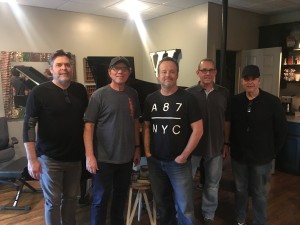 Blair Masters (keys/b3/piano), Mark Baldwin (guitars), Jeff Anderson (me-witty banter), John Hammond (drums) and Gary Lunn (bass)
Blair Masters (keys/b3/piano), Mark Baldwin (guitars), Jeff Anderson (me-witty banter), John Hammond (drums) and Gary Lunn (bass)
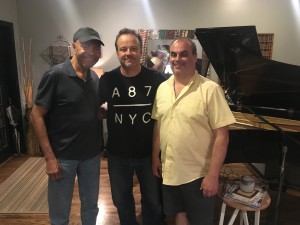 Chester Thompson (drums), Jeff-me, Jim Gray (piano, keys)
Chester Thompson (drums), Jeff-me, Jim Gray (piano, keys)
Tom Reeves (engineer, studio owner, drummer) and Jeff-me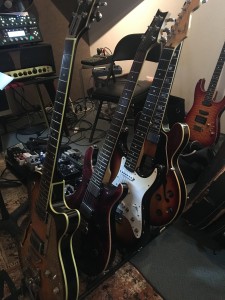
For my guitar player friends, here are Mark Baldwin’s toys for the day.
I’m not exactly sure, but I ‘believe’ the first session I did with Lari Goss back in 1996 had John Hammond on drums and Mark Baldwin on guitars. And both John and Mark have played on a number of my records. Gary Lunn has played bass on a number of my records, including Max Lucado’s Hermie and Friends Scripture Memory Songs records that I wrote and produced. Blair Masters created a spa relaxation CD for us back in the day.
If you’ve ever watched a Tim Akers and The Smoking Section video, you KNOW these folks. Along with Tom Hemby and Tim Akers, these are the ‘regulars’ in The Smoking Section.
The last Smoking Section gig, I was sitting backstage in the green room with Steve (Patrick) and I told Tim ‘So…I used your rhythm section.’ He didn’t drop a beat and said, ‘Are you kidding? I’ve taken all the best guys that you guys use for records and brought them together in The Smoking Section.’
Surround yourself with amazingly gifted musicians, put the musical ideas in front of them and then…well…GET OUT OF THE WAY!!!
We actually live streamed a portion of the day on Facebook. (so you WANT to follow AnderKamp Music on Facebook and send me a friend request)
Here’s the typical process for the tracking of a song:
1. Give the guys the rhythm chart (chords or numbers)
2. Talk through any specifics (repeats, solos, band riffs etc)
3. Play any reference ideas
4. Play through the tune – usually red lighting it
Red Lighting simply means hitting record (red light) so when they’re playing through it, it’s being recorded
5. Talk through the tune, see if it feels good, see if there are changes, see if we’re keeping the tune
6. If we’re not keeping that take, we’ll playlist it, keeping it, just in case, and then recording the next take
7. We’ll talk through the take and see who’s happy with what they did. Whomever wants may ‘go again’ and do another pass but keeping the other players parts. We’ll fix any things that we weren’t happy with.
8. I smiled, giddy as a school boy, at what we had on tape
One of the greatest strengths I believe you can have as a producer is the ability to get out of the way AND to listen to the ideas of the amazing musicians you have hired. And you simply can’t hold on to tightly to a ‘specific, abstract idea’ of what you’re looking to accomplish. It’s happened on every record that I’ve worked on. I’ve come in with a ‘specific’ idea in my head and told the guys what I’m thinking and I get suggestions from the guys. Sometimes it’s taking my idea and making it better. And sometimes it’s suggesting another direction. I remember a moment on this session when I was talking about groove ideas to John Hammond, the drummer. Now John and I have known each other a very long time. I trust him so much for his instincts. I remember telling him my idea and I think the general response from him was, “Yeah…Jeff…that’s not really what you want.” He was telling me that he understood what I was thinking but what I was saying wasn’t the best way to do that.
He was right. So I chose wisely and went with him.
And there’s an inside joke going around with some of the guys I’ve used on quite a number of records about one of my references. I was working on a series of kid’s songs and I wrote ‘Shaft’ feel a tune. For band guys, when you say that, a 70’s funk guitar wah wah groove IMMEDIATELY comes to mind. The tempo for the ‘Shaft’ theme song is probably 117/118 bpm. I think one of the songs that I asked for that feel on was probably 160 bpm. Just way to fast to even attempt it. The guys got a pretty great kick out of the fact that I was asking for something but I what I wanted was NOT what I was saying. But it was in the ballpark (I wanted a funky wah wah). So, for the next record I did with those guys, on every rhythm chart for every song, I put the groove description and then wrote ‘or ‘Shaft’ feel’
One of them was 120 bpm polka ‘or Shaft feel’.
But there’s something to this for me. Having a group of guys that I trust and I am comfortable enough to say, “I think this is what I want. Do I want that?” is critical. If you’re hiring some of the best musicians in the world, WHY ON EARTH WOULD YOU NOT WANT TO ASK THEIR INPUT????
So we have GREAT SOUNDING TRACKS with so much energy and emotion. Now what?
It’s time for the horns…
That’s the next blog post


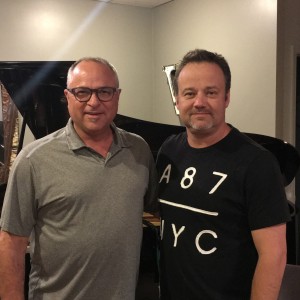

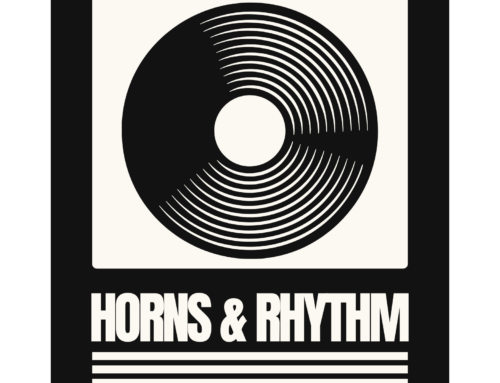
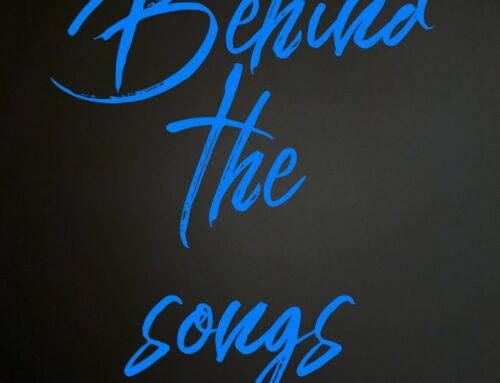
Leave A Comment